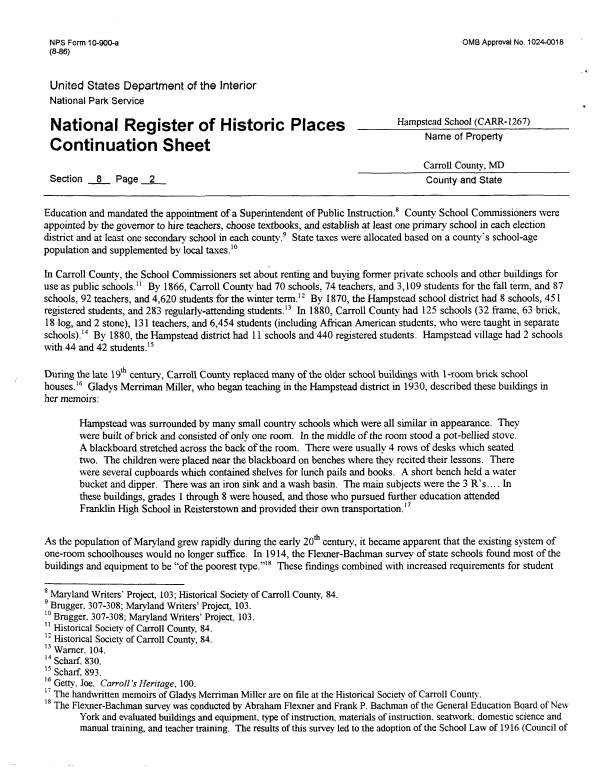|
NPS Form 10-900-a OMB Approval No. 1024-0018 (8-86)
United States Department of the Interior National Park Service
National Register of Historic Places HampsteadSchOQl——
— j- -• *M_ A Name of Property
Continuation Sheet
Carroll County, MD
Section 8 Page 2 County and State
Education and mandated the appointment of a Superintendent of Public Instruction.8 County School Commissioners were appointed by the governor to hire teachers, choose textbooks, and establish at least one primary school in each election district and at least one secondary school in each county.9 State taxes were allocated based on a county's school-age population and supplemented by local taxes.10
In Carroll County, the School Commissioners set about renting and buying former private schools and other buildings for use as public schools." By 1866, Carroll County had 70 schools, 74 teachers, and 3,109 students for the fall term, and 87 schools, 92 teachers, and 4,620 students for the winter term.12 By 1870, the Hampstead school district had 8 schools, 451 registered students, and 283 regularly-attending students.13 In 1880, Carroll County had 125 schools (32 frame, 63 bnck, 18 log, and 2 stone), 131 teachers, and 6,454 students (including African American students, who were taught in separate schools).14 By 1880, the Hampstead district had 11 schools and 440 registered students. Hampstead village had 2 schools with 44 and 42 students.15
During the late 19th century, Carroll County replaced many of the older school buildings with 1-room brick school houses.15 Gladys Merriman Miller, who began teaching in the Hampstead district in 1930, described these buildings in her memoirs:
Hampstead was surrounded by many small country schools which were all similar in appearance. They were built of brick and consisted of only one room. In the middle of the room stood a pot-bellied stove. A blackboard stretched across the back of the room. There were usually 4 rows of desks which seated two. The children were placed near the blackboard on benches where they recited their lessons. There were several cupboards which contained shelves for lunch pails and books. A short bench held a water bucket and dipper. There was an iron sink and a wash basin. The main subjects were the 3 R's.... In these buildings, grades 1 through 8 were housed, and those who pursued further education attended Franklin High School in Reisterstown and provided their own transportation.17
As the population of Maryland grew rapidly during the early 20th century, it became apparent that the existing system of one-room schoolhouses would no longer suffice. In 1914, the Flexner-Bachman survey of state schools found most of the buildings and equipment to be "of the poorest type."18 These findings combined with increased requirements for student
8 Maryland Writers' Project, 103; Historical Society of Carroll County, 84.
9 Brugger, 307-308; Maryland Writers' Project, 103.
10 Brugger, 307-308; Maryland Writers' Project, 103. " Historical Society of Carroll County, 84.
12 Historical Society of Carroll County, 84.
13 Warner. 104.
14 Scharf. 830.
15 Scharf, 893.
16 Getty, Joe. Carroll'sHeritage, 100.
17 The handwritten memoirs of Gladys Merriman Miller are on file at the Historical Society of Carroll County.
18 The Flexner-Bachman survey was conducted by Abraham Flexner and Frank P. Bachman of the General Education Board of New York and evaluated buildings and equipment, type of instruction, materials of instruction, seatvvork, domestic science and manual training, and teacher training. The results of this survey led to the adoption of the School Law of 1916 (Council of
|

